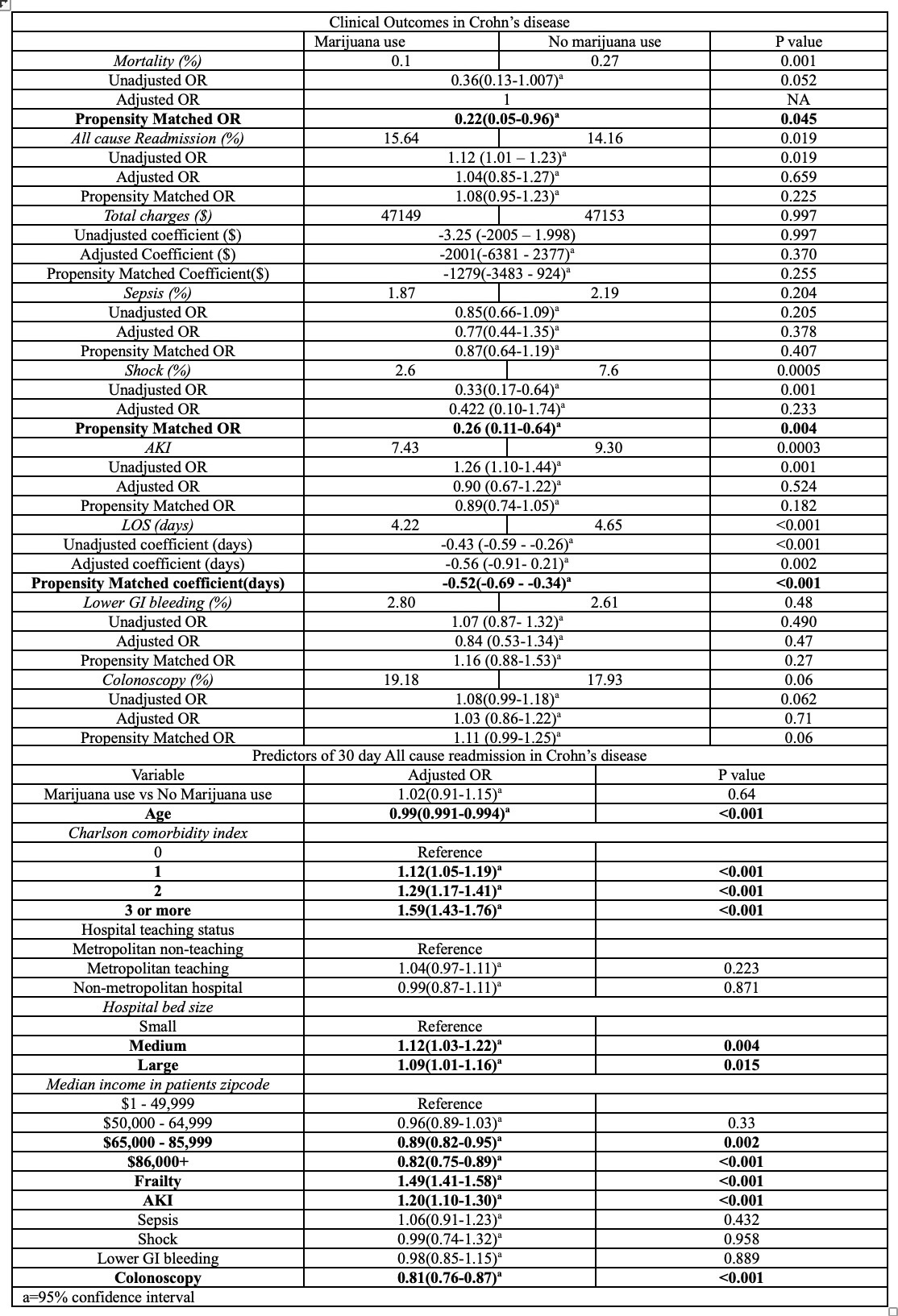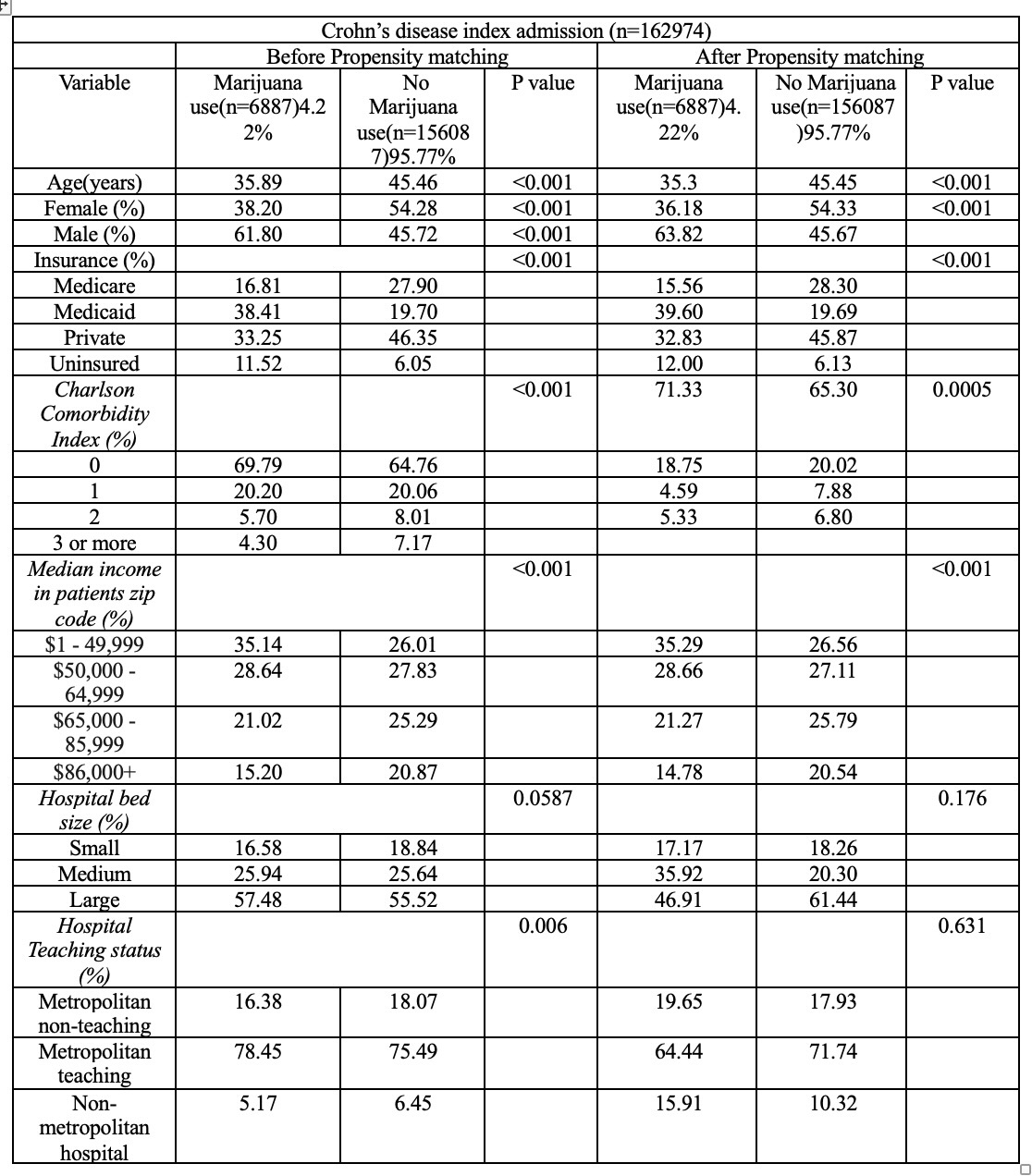Sunday Poster Session
Category: IBD
P1190 - Impact of Marijuana Use in Crohn’s Disease Hospitalizations and Readmissions: A Propensity-Matched Study Using National Readmission Database 2018-2021
Sunday, October 26, 2025
3:30 PM - 7:00 PM PDT
Location: Exhibit Hall
- MK
Maulik Kaneriya, MD
One Brooklyn Health-Interfaith Medical Center
Brooklyn, NY
Presenting Author(s)
Maulik Kaneriya, MD1, Madhav Changela, MD1, Janak Bahirwani, MD2, Nishit Patel, MD3, Krishna Bodrya, MD4, Yecheskel Schneider, MD, MS5
1One Brooklyn Health-Interfaith Medical Center, Brooklyn, NY; 2Kadlec Regional Medical Center, Richland, WA; 3St. Luke's University Health Network, Bethlehem, PA; 4Leigh Valley Health Network, Easton, PA; 5Virtua Health System, Moorestown, NJ
Introduction: Crohn’s disease is a chronic inflammatory disorder that can involve any segment of the gastrointestinal tract and remains a leading cause of gastrointestinal-related hospitalizations. Recent studies have reported a rising trend in marijuana use among individuals with Crohn’s disease, primarily for symptom management. This study aims to assess hospitalization outcomes and readmission rates in patients with Crohn’s disease who use marijuana.
Methods: This is a retrospective analysis using data from the National Readmission Database (NRD) for the years 2018-2020. The study included all patients aged over 18 years who were admitted for Crohn’s disease, stratified into two groups based on marijuana use. Primary were mortality and the all-cause 30-day readmission rate. Secondary outcomes included length of stay(LOS), total hospitalization charges, sepsis, shock, AKI, lower gastrointestinal(GI) bleeding and colonoscopy. A multivariate regression model was employed to evaluate outcomes between the two cohorts, adjusting for potential confounders. To further mitigate confounding bias, propensity scores were estimated using relevant baseline covariates and outcomes were analyzed. A p-value of < 0.05 was considered statistically significant.
Results: Out of 162974 Crohn’s disease admissions, 6887(4.22%) patients used marijuana. Crohn’s disease patient with marijuana use were found to be younger [36 vs 45, p< 0.001]. Basic demographic characteristics are summarized in Table 1, while detailed clinical outcomes are presented in Table 2. Compared to control group, marijuana use cohort was associated with a lower odd of mortality[adjusted odds ratio (aOR)=0.22,p=0.045] and shock[aOR=0.26, p=0.004]. Marijuana cohort was associated with shorter length of stay[adjusted coefficient=-0.52, p< 0.001] compared to control group. There was no significant difference between two groups in readmission, AKI, sepsis, lower GI bleeding Statistically significant independent predictors of 30-day all-cause readmissions for crohn’s disease were age, Charlson comorbidity index, median income, John Hopkins ACG frailty, AKI, and colonoscopy.
Discussion: Our study results were associated with lower odds of inpatient mortality, shock and lower length of stay among marijuana use patients in crohn’s disease. While this study provides interesting insight into the hospitalization outcomes and readmissions among crohn’s disease patient, further research is needed to validate this study findings.

Figure: Table 1: Patient demographic characteristics.

Figure: Table 2: Clinical outcomes and Predictors of all cause 30-day readmissions in Crohn's disease
Disclosures:
Maulik Kaneriya indicated no relevant financial relationships.
Madhav Changela indicated no relevant financial relationships.
Janak Bahirwani indicated no relevant financial relationships.
Nishit Patel indicated no relevant financial relationships.
Krishna Bodrya indicated no relevant financial relationships.
Yecheskel Schneider indicated no relevant financial relationships.
Maulik Kaneriya, MD1, Madhav Changela, MD1, Janak Bahirwani, MD2, Nishit Patel, MD3, Krishna Bodrya, MD4, Yecheskel Schneider, MD, MS5. P1190 - Impact of Marijuana Use in Crohn’s Disease Hospitalizations and Readmissions: A Propensity-Matched Study Using National Readmission Database 2018-2021, ACG 2025 Annual Scientific Meeting Abstracts. Phoenix, AZ: American College of Gastroenterology.
1One Brooklyn Health-Interfaith Medical Center, Brooklyn, NY; 2Kadlec Regional Medical Center, Richland, WA; 3St. Luke's University Health Network, Bethlehem, PA; 4Leigh Valley Health Network, Easton, PA; 5Virtua Health System, Moorestown, NJ
Introduction: Crohn’s disease is a chronic inflammatory disorder that can involve any segment of the gastrointestinal tract and remains a leading cause of gastrointestinal-related hospitalizations. Recent studies have reported a rising trend in marijuana use among individuals with Crohn’s disease, primarily for symptom management. This study aims to assess hospitalization outcomes and readmission rates in patients with Crohn’s disease who use marijuana.
Methods: This is a retrospective analysis using data from the National Readmission Database (NRD) for the years 2018-2020. The study included all patients aged over 18 years who were admitted for Crohn’s disease, stratified into two groups based on marijuana use. Primary were mortality and the all-cause 30-day readmission rate. Secondary outcomes included length of stay(LOS), total hospitalization charges, sepsis, shock, AKI, lower gastrointestinal(GI) bleeding and colonoscopy. A multivariate regression model was employed to evaluate outcomes between the two cohorts, adjusting for potential confounders. To further mitigate confounding bias, propensity scores were estimated using relevant baseline covariates and outcomes were analyzed. A p-value of < 0.05 was considered statistically significant.
Results: Out of 162974 Crohn’s disease admissions, 6887(4.22%) patients used marijuana. Crohn’s disease patient with marijuana use were found to be younger [36 vs 45, p< 0.001]. Basic demographic characteristics are summarized in Table 1, while detailed clinical outcomes are presented in Table 2. Compared to control group, marijuana use cohort was associated with a lower odd of mortality[adjusted odds ratio (aOR)=0.22,p=0.045] and shock[aOR=0.26, p=0.004]. Marijuana cohort was associated with shorter length of stay[adjusted coefficient=-0.52, p< 0.001] compared to control group. There was no significant difference between two groups in readmission, AKI, sepsis, lower GI bleeding Statistically significant independent predictors of 30-day all-cause readmissions for crohn’s disease were age, Charlson comorbidity index, median income, John Hopkins ACG frailty, AKI, and colonoscopy.
Discussion: Our study results were associated with lower odds of inpatient mortality, shock and lower length of stay among marijuana use patients in crohn’s disease. While this study provides interesting insight into the hospitalization outcomes and readmissions among crohn’s disease patient, further research is needed to validate this study findings.

Figure: Table 1: Patient demographic characteristics.

Figure: Table 2: Clinical outcomes and Predictors of all cause 30-day readmissions in Crohn's disease
Disclosures:
Maulik Kaneriya indicated no relevant financial relationships.
Madhav Changela indicated no relevant financial relationships.
Janak Bahirwani indicated no relevant financial relationships.
Nishit Patel indicated no relevant financial relationships.
Krishna Bodrya indicated no relevant financial relationships.
Yecheskel Schneider indicated no relevant financial relationships.
Maulik Kaneriya, MD1, Madhav Changela, MD1, Janak Bahirwani, MD2, Nishit Patel, MD3, Krishna Bodrya, MD4, Yecheskel Schneider, MD, MS5. P1190 - Impact of Marijuana Use in Crohn’s Disease Hospitalizations and Readmissions: A Propensity-Matched Study Using National Readmission Database 2018-2021, ACG 2025 Annual Scientific Meeting Abstracts. Phoenix, AZ: American College of Gastroenterology.
